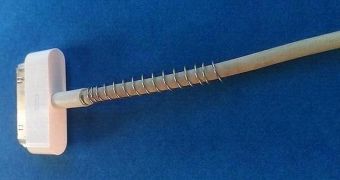Around half of the iDevice install base still uses the 30-pin USB cable that has been known to fray at the ends, while Lightning cables are also not 100% tear-proof (like just about anything in this world). But there’s an easy way to protect their ends from unraveling (read the cautionary notes at the end of the post before doing anything).
WOW Facts Of Life today shared someone’s ingenious way of addressing the fraying issue experienced by thousands of iPhone owners over the years. While the newer Lightning cables are less prone to this kind of damage, they’re not fray-proof.
This is what you can do to prevent the rubber from becoming undone at the ends. Simply take the spring/coil from a pen and wrap it around the end of the cable, particularly that which holds the plug that goes into your iPhone/iPad/iPod touch.
Again, this solution is mostly targeted at the 30-pin cables for older-generation devices, but it works just as well for the newer Lightning port cables.
Now for a few words of advice.
1. You should only attempt to do this if the fraying process hasn’t started yet. If your cable is already showing signs of fraying, that means the wires inside could already be exposed. Strapping a metal coil around them could cause the charger to short out, or even shock you. The best thing to do if your cable is already damaged is to take it to Apple (if your device is still under warranty), or buy a new one.
2. This “solution” isn’t in any way an official fix. Apple will not take responsibility for anything that might go wrong as a result of you covering the wire with a metal spring, and neither will Softpedia for that matter. Also, it’s best if you find an insulated spring/coil (some pens have that) that doesn’t allow the metal to touch your skin. A plastic spring is much better, if you can find one.
3. Under no circumstances should you try this on a knockoff charger. As you may have heard, some people ended up dead because they charged their iPhones with fake chargers, so make sure both your cable and your charger are genuine.
In a nutshell, use this method at your own risk and be careful not to apply it on a cable that already shows signs of damage. You’ve been warned.

 14 DAY TRIAL //
14 DAY TRIAL //